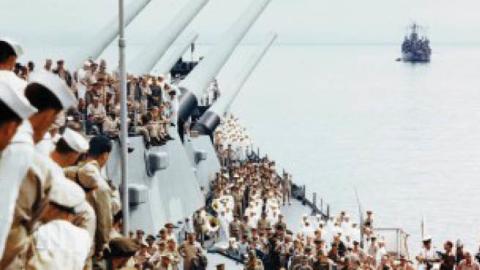Tday the guns are silent. A great tragedy has ended. A great victory has been won.”
Those were Douglas MacArthur’s words following the signing of Japan’s unconditional surrender on board the battleship USS Missouri in Tokyo Bay, September 2, 75 years ago. That signing ceremony ended the last phase of World War II, the bloodiest war in history. As MacArthur indicated, it also opened a new era in the relationship between the United States and Asia, in which the once-defeated Japan has come to play a pivotal part.
After being America’s mortal enemy, Japan has become the U.S.’s closest and oldest ally in Asia. This is a tribute not only to generations of leadership in both countries, but also to the hopes that MacArthur set in motion on that day.
On the one hand, the ceremony of V-J Day was a magnificent display of American power. On board the USS Missouri were representatives of an international coalition to defeat imperial Japan that included the Soviet Union as well as Great Britain and its Dominions, and China.
Tokyo Bay itself was filled with American warships as far as the eye could see. When the surrender ceremony was completed, MacArthur staged an overflight of more than 1,500 Navy warplanes and 400 B-29s, the super bomber that had dropped the most destructive weapon ever devised, the atomic bomb, on Hiroshima and Nagasaki to hasten Japan’s unconditional surrender.
The war Japan had set in motion had cost more than 17 million lives, most of them noncombatants, not including some 5 million Japanese. From Pearl Harbor to Iwo Jima and Okinawa, more than 111,606 American lives had been lost in the Pacific theater, including thousands of Americans starved and tortured in Japanese POW camps.
If any nation deserved condemnation and opprobrium in 1945, it was Japan.
Yet MacArthur had also brought on board the Missouri the pennant that Commodore Matthew Perry had flown from his flagship, when he had sailed into Tokyo Bay in 1853. “His purpose,” MacArthur told his audience, both on shipboard and on a global radio hookup, “was to bring to Japan an era of enlightenment and progress by lifting the veil of isolation to the friendship, trade, and commerce of the world” — a pledge that extended not just to Japan in MacArthur’s mind but to all of Asia, whose “unshackled peoples are tasting the full sweetness of liberty, the relief from fear.”
Fulfilling that pledge was what MacArthur strove to do as head of Allied occupation forces in Japan for the next five years, as well as during his stint as the supreme commander of United Nations forces during the Korean War, when he took on the responsibility of defeating the twin Communist powers of North Korea and China — the two important threats to freedom in Asia to this day.
With regard to Japan, MacArthur succeeded beyond anyone’s expectations. The country sprang up from the ruins of war to become the second-biggest economy in the world by 1968. Even today, Japan remains the third-largest, after the U.S. and China. After renouncing its ugly militarist past, Japan became a major source of humanitarian support and commerce across Asia and around the world — while also allowing the U.S. to establish bases on its soil to anchor its defense of the free world in Asia during the Cold War and beyond.
In this past decade, Japan has been stepping into a new role, as America’s most important defense partner in Asia. Under Prime Minister Shinzo Abe, Japan has been shouldering more and more of the defense burden assumed by both countries under their mutual security pact signed in 1951 — the oldest continuous security pact the United States still enjoys. Together with President Trump, Abe has been moving to develop a common strategy to contain Beijing’s hegemonic ambitions in Asia.
By a strange irony, China and Japan have switched historical roles since V-J Day. Seventy-five years ago, it was imperial Japan that was the disruptor of peace and security across the region, and China served as America’s ally. Now it is Communist China that has assumed the aggressor role, while democratic Japan stands foursquare with the United States in defense of freedom and a “free and open Indo-Pacific” — a phrase that both Abe and Trump have adopted to describe the vision of a peaceful and prosperous hemisphere extending from the Indian Ocean to the shores of California.
Last week, Prime Minister Abe announced that he was stepping down as premier. He leaves behind a growing “special relationship” between the U.S. and Japan, from trade deals and joint military exercises to shared research in advanced science and technology. It’s a legacy that whoever occupies the Oval Office in January 2021 can build on, while also reflecting on the strange historical fate that two countries who were fighting a total war against each other 75 years ago are now the closest of friends and strategic partners.
It’s not only a tribute to how time changes attitudes and perceptions. It’s also a tribute to one man’s vision, General Douglas MacArthur’s, for how American power, after the horrors of war, could create a lasting legacy of freedom.
Read in National Review



















